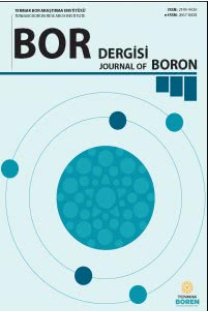Boron in combination with calcium reduces sunburn in apple fruit
Golden Delicious, peel mineral analyses, Sunburn browning,
___
- [1] Racskó J., Schrader L. E., Sunburn of apple fruit: Historical background, recent advances and future perspectives, CRC. Crit. Rev. Plant Sci., 31, 455–504, 2012. [2] IPCC, Climate Change 2007: Impacts, adaptation and vulnerability: Contribution of Working Group II to the fourth assessment report of the Intergovernmental Panel, Genebra, Suíça, Cambridge, 2007.
- [3] Daiber S. H., Quantifying changes in tree physiology after amelioration to reduce sunburn on apples, MScAgric Thesis, Stellenbosch University, Department of Horticultural Science, Stellenbosch, 2017.
- [4] Lötze E., Hoffman E. W., Foliar application of calcium plus boron reduces the incidence of sunburn in 'Golden Delicious' apple, J. Hortic. Sci. Biotechnol., 89 (6), 607–612, 2014.
- [5] Felicetti D., Schrader L., Changes in pigment concentrations associated with the degree of sunburn browning of ‘Fuji’ apple, J. Am. Soc. Hortic. Sci., 133, 27–34, 2008.
- [6] Schrader L. E., Zhang J., Duplaga W. K., Two types of sunburn in apple caused by high fruit surface (peel) temperature, Plant Heal. Prog. 2001.
- [7] DAFF/PPECB, Annual Report 2014-2015, South Africa, 2015 (http://www.daff.gov.za/.).
- [8] Hortgro, Deciduous Fruit Statistics, South Afrca, 2015 (www.hortgro.co.za).
- [9] Makeredza B., Schmeisser M., Lötze E., Steyn W. J., Water stress increases sunburn in 'Cripps' Pink’ apple, Hort Science, 48, 444–447, 2013.
- [10] Bogo A., Casa R. T., Agostineto L., Gonçalves M. J., Rufato L., Effect of hail protection nets on apple scab in ‘Royal Gala’ and ‘Fuji’ apple cultivars, Crop Prot., 38, 49–52, 2012.
- [11] Hunsche M., Blanke M. M., Noga G., Does the microclimate under hail nets influence micromorphological characteristics of apple leaves and cuticles?, J. Plant Physiol., 167, 974–80, 2010.
- [12] Gindaba J., Wand S. J. E., Comparative effects of evaporative cooling, kaolin particle film, and shade net on sunburn and fruit quality in apples, HortScience, 40, 592–596, 2005.
- [13] Gindaba J., Wand S. J. E., Do fruit sunburn control measures affect leaf photosynthetic rate and stomatal conductance in ‘Royal Gala’ apple?, Environ. Exp. Bot., 59, 160–165, 2007.
- [14] Iglesias I., Alegre S., The effect of anti-hail nets on fruit protection , radiation , temperature , quality and profitability of ‘Mondial Gala’ apples, J. App. Hortic., 8, 91–100, 2006.
- [15] Marais S., Sunburn control in apple fruit, MSc Agric Thesis, Department of Horticultural Science, Stellenbosch University, Stellenbosch, 2005.
- [16] Erez A., Glenn D. M., The Effect of Particle Film Technology on Yield and Fruit Quality, Acta Hortic., 636, 505–508, 2004.
- [17] Glenn D. M., Prado E., Erez A., McFerson J., Puterka G. J., A reflective, processed-kaolin particle film affects fruit temperature, radiation reflection, and solar injury in apple, J. Am. Soc. Hortic. Sci., 127, 188–193, 2002.
- [18] Cakmak I., Römheld V., Boron deficiency-induced impairments of cellular functions in plants, Plant and Soil, 193, 71, 1997.
- [19] Felicetti D. A., Schrader L. E., Photooxidative sunburn of apples: Characterization of a third type of apple sunburn, Int. J. Fruit Sci., 8, 160–172, 2008.
- [20] Ruiz J. M., Bretones G., Baghour M., Ragala L., Belakbir A., Romero L. Relationship between boron and phenolic metabolism in tobacco leaves, Phytochem, 48 (2), 269–272,1998.
- [21] Blevins D. G., Lukaszewski K. M. Boron in plant structure and function, Annu. Rev. Plant Physiol. Plant Mol. Biol., 49, 481–500,1998.
- [22] Brown P. H., Bellaloui N., Wimmer M. A., Bassil E. S., Ruiz J., Hu H., Pfeffer H., Dannel F., Romheld V. Boron in plant biology, Plant Biol. 4 (2), 205–223, 2002.
- [23] Lombardo S., Pandino G., Mauro R., Mauromicale G. Variation of phenolic content in globe artichoke in relation to biological, technical and environmental factors, Ital. J. Agron., 4,181–189, 2009.
- [24] Stael S., Rocha A. G., Wimberger T., Anrather D., Vothknecht U. C., Teige M. Cross-talk between calcium signalling and protein phosphorylation at the thylakoid, J. Exp. Bot., 63, 1725–1733, 2012.
- [25] Felicetti D., Schrader L. Changes in pigment concentrations associated with the degree of sunburn browning of “Fuji” apple, J. Am. Soc. Hortic. Sci., 133 (1), 27–34, 2008.
- [26] Felicetti D. A.,Schrader L. E Changes in pigment concentrations associated with sunburn browning of five apple cultivars, II. Phenolics, Plant Sci., 176,84–89, 2009.
- ISSN: 2149-9020
- Yayın Aralığı: 4
- Başlangıç: 2016
- Yayıncı: TENMAK Bor Araştırma Enstitüsü
Boron in arid zone agriculture: Israeli case studies
Boron in combination with calcium reduces sunburn in apple fruit
Elmi LÖTZE, Stephan H. DALBER, Stephanie J. E MİDGLEY
Bor elementinin bitkiler için önemi
Aydın GÜNEŞ, Sait GEZGİN, Kadriye KALİNBACAK, Hesna OZCAN, İsmail CAKMAK
Erdinç UYSAL, Oğuz Fehmi ŞEN, Özlem Bengü DAŞ KILIÇ, Nuri CANDAN, Neslihan UZUN, Kürşat ÜNER, Barış ALBAYRAK, Mustafa BIYIKLI, Gülşah ÜĞLÜ, Nalan RAHMANOĞLU
Historical and recent aspects of boron in human and animal health
